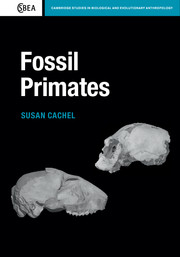Book contents
- Frontmatter
- Dedication
- Contents
- Acknowledgments
- Preface
- 1 Introduction: primates in evolutionary time
- 2 Primate taxonomy
- 3 Fossils and fossilization
- 4 The world of the past
- 5 The lifeways of extinct animals
- 6 Evolutionary processes and the pattern of primate evolution
- 7 Primate origins
- 8 The Paleocene primate radiation
- 9 The Eocene primate radiation
- 10 The Malagasy primate radiation
- 11 The Oligocene bottleneck
- 12 Rise of the anthropoids
- 13 The platyrrhine radiation
- 14 The Miocene hominoid radiation
- 15 The cercopithecoid radiation
- 16 Late Cenozoic climate changes
- 17 Conclusions
- References
- Index
4 - The world of the past
Published online by Cambridge University Press: 05 April 2015
- Frontmatter
- Dedication
- Contents
- Acknowledgments
- Preface
- 1 Introduction: primates in evolutionary time
- 2 Primate taxonomy
- 3 Fossils and fossilization
- 4 The world of the past
- 5 The lifeways of extinct animals
- 6 Evolutionary processes and the pattern of primate evolution
- 7 Primate origins
- 8 The Paleocene primate radiation
- 9 The Eocene primate radiation
- 10 The Malagasy primate radiation
- 11 The Oligocene bottleneck
- 12 Rise of the anthropoids
- 13 The platyrrhine radiation
- 14 The Miocene hominoid radiation
- 15 The cercopithecoid radiation
- 16 Late Cenozoic climate changes
- 17 Conclusions
- References
- Index
Summary
The origin of continents and oceans
The title of this section is a translation of a book first written by the meteorologist Alfred Wegener in 1915, and revised and translated many times afterwards. Wegener proposed that a giant supercontinent (Pangaea) had once existed. Portions of this supercontinent split apart and moved away, creating ocean basins and the modern geography of the earth. This hypothesis was called continental drift. However, although Wegener amassed data on the similarity of continental coastlines (especially South America and South Africa), geological strata, and animal and plant distributions to support his hypothesis, he had no workable mechanism to explain the movements of the fragmented supercontinent. Most geologists considered Wegener to be an eccentric crank, although biologists appreciated the fact that continental drift eliminated the necessity for invoking land bridges to explain animal and plant distributions; and biologists further applauded the fact that continental drift rendered massive parallel evolution unnecessary. Wegener’s hypothesis was resurrected in the 1960s, which witnessed a revolution in geological thought. Using new evidence about earthquake and volcanic belts, paleomagnetism, and sea-floor spreading, geologists outlined a new mechanism of continental movement called plate tectonics.
Movements (tectonics) affect plates of lithosphere. Convection currents deep within the mantle of the earth are the ultimate cause of these movements. These convection currents are driven by heat. Radioactive materials exist within the mantle. Their natural decay processes emit heat, and thus a molten iron core lies underneath the mantle. Movements within the mantle drag the overlying crust, and upwelling mantle plumes create local hotspots of volcanic activity, as observed in the Hawaiian Islands. These deep mantle plumes and hotspots can be tracked by volcanic islands and submarine sea mounts as plates pass over the plumes. These plumes can also affect the speed of plate movements and the intensity of volcanic eruptions. For example, the Réunion plume in the Indian Ocean is responsible for the simultaneous rapid motion of the Indian plate and slowing of the African plate beginning 67 mya (Cande & Stegman, 2011). The enormous Indian Deccan flood basalts are adjacent to the Réunion plume, and begin erupting at the same time. These massive volcanic eruptions contribute to the major extinctions that occur at the K/T boundary.
- Type
- Chapter
- Information
- Fossil Primates , pp. 59 - 65Publisher: Cambridge University PressPrint publication year: 2015

